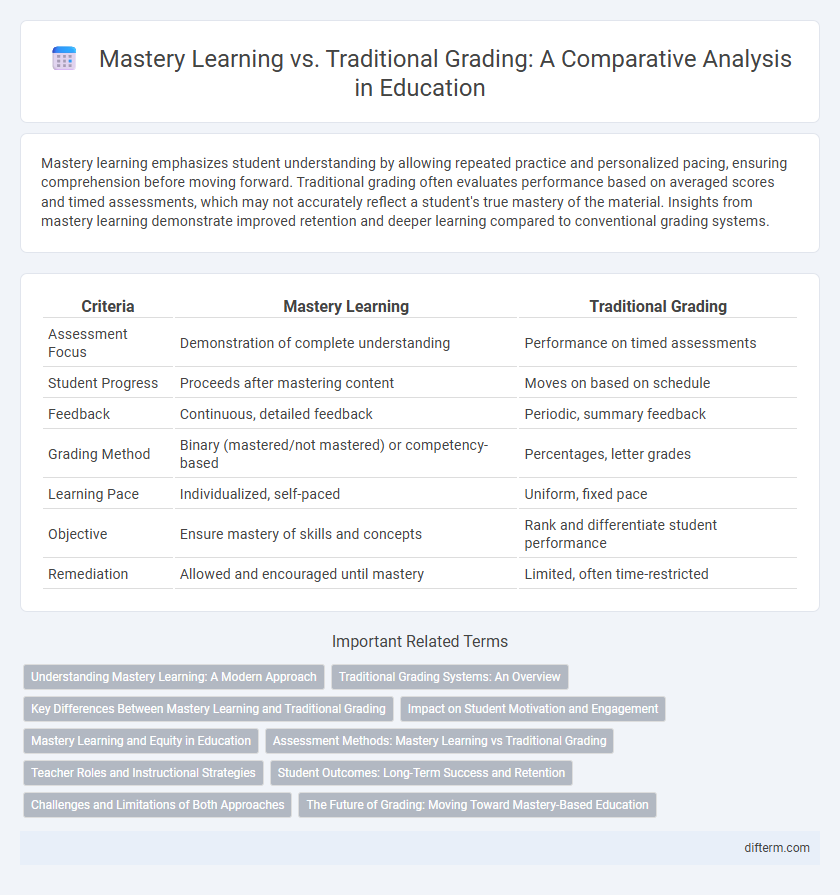Mastery learning emphasizes student understanding by allowing repeated practice and personalized pacing, ensuring comprehension before moving forward. Traditional grading often evaluates performance based on averaged scores and timed assessments, which may not accurately reflect a student's true mastery of the material. Insights from mastery learning demonstrate improved retention and deeper learning compared to conventional grading systems.
Table of Comparison
| Criteria | Mastery Learning | Traditional Grading |
|---|---|---|
| Assessment Focus | Demonstration of complete understanding | Performance on timed assessments |
| Student Progress | Proceeds after mastering content | Moves on based on schedule |
| Feedback | Continuous, detailed feedback | Periodic, summary feedback |
| Grading Method | Binary (mastered/not mastered) or competency-based | Percentages, letter grades |
| Learning Pace | Individualized, self-paced | Uniform, fixed pace |
| Objective | Ensure mastery of skills and concepts | Rank and differentiate student performance |
| Remediation | Allowed and encouraged until mastery | Limited, often time-restricted |
Understanding Mastery Learning: A Modern Approach
Mastery learning emphasizes achieving a deep understanding of subject material before progressing, contrasting with traditional grading that often focuses on accumulating points or percentages. This approach allows students to learn at their own pace, ensuring foundational skills are solidified, which leads to improved long-term retention and higher academic performance. Research shows mastery learning reduces achievement gaps and supports personalized instruction, making it a transformative strategy in modern education systems.
Traditional Grading Systems: An Overview
Traditional grading systems rely on cumulative point-based assessments and letter grades to evaluate student performance, often emphasizing summative tests and homework completion. These systems prioritize ranking and comparison over individual skill mastery, resulting in a fixed measure of achievement that may not reflect true understanding. Critics argue that traditional grading can discourage deeper learning and fail to accommodate diverse learning paces and styles.
Key Differences Between Mastery Learning and Traditional Grading
Mastery learning emphasizes achieving a deep understanding of specific skills before progressing, whereas traditional grading relies on cumulative scores and time-based assessments. In mastery learning, students receive targeted feedback and multiple opportunities to demonstrate competence, contrasting with traditional grading's fixed deadlines and one-time evaluations. This approach fosters individualized pacing and ensures mastery of content rather than averaging performance across various tasks.
Impact on Student Motivation and Engagement
Mastery learning enhances student motivation and engagement by emphasizing understanding and skill proficiency over numeric grades, fostering a growth mindset. Traditional grading often leads to performance anxiety and surface-level learning, as students focus on earning high scores rather than mastering content. Research shows that mastery learning increases intrinsic motivation and sustained academic effort, resulting in deeper knowledge retention.
Mastery Learning and Equity in Education
Mastery learning promotes equity in education by ensuring all students achieve a high level of understanding before progressing, reducing achievement gaps common in traditional grading systems that often prioritize ranking over comprehension. This approach tailors instruction to individual learning needs, allowing students from diverse backgrounds to succeed at their own pace and fostering inclusive academic environments. Research indicates mastery learning improves retention and motivation, particularly benefiting underserved populations by emphasizing growth and mastery rather than comparative performance.
Assessment Methods: Mastery Learning vs Traditional Grading
Mastery learning employs formative assessments that provide ongoing feedback, allowing students to demonstrate proficiency before advancing, which contrasts with traditional grading's reliance on summative assessments focused on cumulative scores. This approach prioritizes individual student growth and mastery of specific skills, rather than averaging performance across deadlines and varied assignments. Research indicates mastery learning improves retention and understanding by emphasizing mastery criteria over normative ranking found in traditional grading systems.
Teacher Roles and Instructional Strategies
Mastery learning emphasizes the teacher's role as a facilitator who provides personalized feedback and adapts instructional strategies to meet each student's pace and needs, contrasting with traditional grading where instruction is often uniform and time-bound. Teachers in mastery learning implement formative assessments to identify learning gaps and use targeted interventions, fostering deeper understanding rather than assigning grades based on averaged performance. Instructional strategies in mastery learning prioritize differentiated instruction, flexible pacing, and competency-based progression, enhancing student engagement and mastery of content compared to the standardized approach of traditional grading systems.
Student Outcomes: Long-Term Success and Retention
Mastery learning significantly improves long-term student success and retention by ensuring comprehension before progression, leading to deeper knowledge retention and higher academic achievement. Traditional grading often emphasizes performance over understanding, resulting in gaps that hinder sustained learning outcomes. Research indicates that students under mastery learning demonstrate enhanced critical thinking skills and greater persistence in educational pursuits.
Challenges and Limitations of Both Approaches
Mastery learning faces challenges such as increased instructional time and the need for personalized pacing, making it difficult to implement in large, diverse classrooms. Traditional grading often struggles with fairness and motivation, as it emphasizes cumulative scores that may not accurately reflect individual student understanding. Both approaches are limited by varying student needs and the complexities of accurately assessing learning progress.
The Future of Grading: Moving Toward Mastery-Based Education
Mastery-based education emphasizes student understanding and skill proficiency over traditional point accumulation, promoting deeper learning and personalized pacing. This approach shifts grading from arbitrary scores to clear demonstration of competencies, improving motivation and academic outcomes. Emerging educational models and digital platforms increasingly support mastery learning, signaling a transformative future for grading systems worldwide.
mastery learning vs traditional grading Infographic

 difterm.com
difterm.com